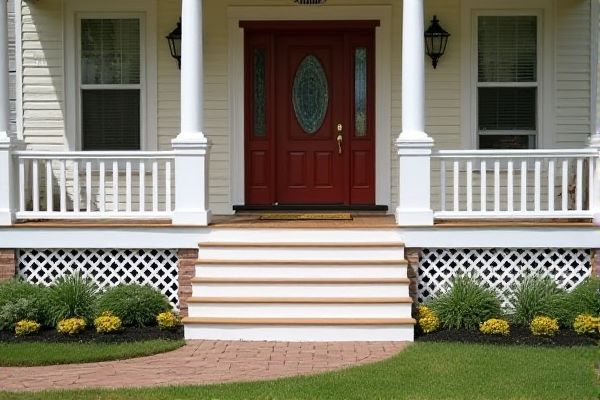
Lattice skirting offers a decorative, breathable option that promotes air circulation and pest control, while solid skirting provides a more durable, weather-resistant barrier for your porch. Discover which skirting type best suits your needs and enhances your outdoor space by reading the rest of the article.
Table of Comparison
| Feature | Lattice Skirting | Solid Skirting |
|---|---|---|
| Material | Wood, vinyl, or composite with crisscross design | Wood, vinyl, composite, or metal panels |
| Appearance | Decorative, airy, allows visibility | Clean, uniform, fully opaque |
| Ventilation | High airflow and moisture control | Limited airflow, can trap moisture if not vented |
| Privacy | Low to moderate privacy, semi-transparent | High privacy, blocks view completely |
| Installation | Easy to install and replace sections | Requires precise fitting and sealing |
| Maintenance | May require painting or cleaning between lattice spaces | Requires cleaning; less prone to debris buildup |
| Durability | Moderate, susceptible to damage from impact | High, offers greater protection against elements |
| Cost | Generally lower cost upfront | Typically higher cost due to material and installation |
Introduction to Porch Skirting Options
Porch skirting options include lattice skirting and solid skirting, each serving distinct functional and aesthetic purposes. Lattice skirting provides ventilation and a decorative pattern that enhances curb appeal while preventing debris and animals from entering beneath the porch. Solid skirting offers increased privacy, durability, and protection from weather elements by completely enclosing the porch base with materials like wood or vinyl panels.
What is Lattice Skirting?
Lattice skirting is a type of porch enclosure made from crisscrossed wooden or vinyl strips that create a diamond or square pattern, allowing for ventilation and visual appeal. It helps to conceal the space beneath the porch while providing airflow to prevent moisture buildup and pest infestations. Compared to solid skirting, lattice skirting offers a decorative element and improved ventilation but may require more maintenance due to its open design.
What is Solid Skirting?
Solid skirting is a continuous, non-perforated material like plywood, vinyl, or metal installed around the base of a porch to enclose and protect the area beneath. It enhances structural stability, prevents pests from entering, and improves the appearance by providing a seamless, finished look. Unlike lattice skirting, solid skirting offers better insulation and security due to its solid, impenetrable surface.
Aesthetic Comparison: Lattice vs Solid Skirting
Lattice skirting offers a visually appealing, open design that enhances porch airflow while adding textured patterns for a charming, rustic look. Solid skirting provides a clean, uniform appearance with greater privacy and protection from pests, contributing to a polished and traditional aesthetic. Choosing between lattice and solid skirting depends on balancing decorative appeal with functional needs such as ventilation and concealment.
Installation and Maintenance Differences
Lattice skirting for porches offers easier installation due to its lightweight panels that can be attached directly to existing frames without extensive structural modifications, while solid skirting often requires more precise measurements and secure fastening for durability. Maintenance for lattice skirting involves regular cleaning to prevent debris buildup within the openings and occasional repainting or sealing to protect against weather damage, whereas solid skirting demands more frequent inspection for rot, warping, and pest control due to its continuous surface exposure. Choosing lattice skirting simplifies airflow and drainage maintenance, while solid skirting provides a sturdier barrier but necessitates higher upkeep efforts to maintain structural integrity.
Ventilation and Moisture Control
Lattice skirting enhances ventilation by allowing air to circulate freely beneath the porch, significantly reducing moisture buildup and preventing mold and wood rot. Solid skirting, while offering a more polished appearance, restricts airflow, which can trap moisture and increase the risk of structural damage over time. Effective moisture control is crucial for porch longevity, making lattice skirting a preferred choice for maintaining a dry, well-ventilated space.
Durability and Longevity
Lattice skirting offers ventilation benefits but tends to be less durable and more prone to damage from weather and pests compared to solid skirting. Solid skirting provides superior protection and longevity due to its robust materials that resist rot, moisture, and impact over time. Choosing solid skirting for your porch enhances durability and reduces maintenance, ensuring long-lasting structural support.
Cost Comparison: Lattice vs Solid Skirting
Lattice skirting typically costs less than solid skirting due to its lightweight materials and simpler installation process, with prices ranging from $1 to $3 per square foot compared to $3 to $7 per square foot for solid options. Solid skirting requires more durable materials like wood or vinyl panels, which increase both material and labor expenses. Choosing lattice can reduce upfront costs and provide airflow benefits, while solid skirting offers enhanced privacy and protection at a higher price point.
Customization and Design Flexibility
Lattice skirting offers extensive customization options with its grid-like pattern, allowing for various spacing, paint colors, and materials that enhance ventilation and aesthetic appeal around porches. Solid skirting provides a sleek, uniform look ideal for concealing foundational elements but offers less design flexibility and limited airflow options. Homeowners seeking personalized designs and improved ventilation often prefer lattice skirting, while those prioritizing durability and privacy may choose solid skirting.
Choosing the Right Skirting for Your Porch
Choosing the right skirting for your porch involves evaluating both lattice skirting and solid skirting based on aesthetics and functionality. Lattice skirting offers ventilation, prevents pests, and adds decorative appeal with its crisscross pattern, making it ideal for ensuring airflow under your porch. Solid skirting provides a more uniform, sturdy barrier for privacy and protection against weather elements, perfect if you prefer a sleek, enclosed look for your outdoor space.
 homyna.com
homyna.com